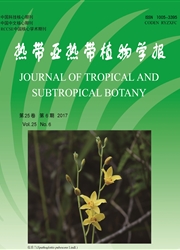

 中文摘要:
中文摘要:
研究了采自福建九龙江口的3种红树植物,秋茄(Kandelia candel)、木榄Bruguiera gymnorrhixa)和红海榄(Rhizophora stylosa)的叶片结构并探讨了其生态学意义。结果表明,这3种红树植物叶片都具有适应海生环境的结构,较厚的角质层,表皮之内有内皮层,内皮层属贮水组织;气孔都分布在下表皮,下陷,并有大的孔下室;中脉有发达的维管束,其导管粗大。从叶片的横切面来看,秋茄叶片具有对称的结构,为等面叶:木榄和红海榄的叶片结构不对称,为异面叶。3种植物叶内都含有较丰富的单宁,以秋茄最高,红海榄次之,木榄最少。这些结构差异可为物种鉴定提供依据。
 英文摘要:
英文摘要:
The leaves of three mangrove species, Kandelia candel (L.) Druce, Bruguiera gymnorrhiza (L.) Blume and Rhizophora stylosa Griff., collected from the access to Jiulong River, Fujian, were studied anatomically. Results showed that the three species were adapt to aquatic environment in structure:having thicker cuticle, epidermis with hypodermis as aquiferous tissue, stomata sunk in and distributed in lower epidermis, with large substomatal chambers, developed vascular bundles with enlarged vessels in mid rib. Cross section views indicated that leaves of K. candel was isolateral with symmetric structure, whereas those of B. gymnorrhiza and R. stylosa were dorsi-ventral and asymmetric. Leaves of all the 3 species were abundant in tannin that was richest in K. candel, followed by R. stylosa and B. gymnorrhiza. The differences in leaf structure could help specific identification in taxonomy.
 同期刊论文项目
同期刊论文项目
 同项目期刊论文
同项目期刊论文
 期刊信息
期刊信息
